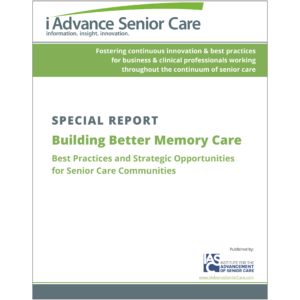The obesity challenge
Our next great challenge may be one that we have not worried about in many years: weight gain and obesity. General population trends of aging, obesity, and its complications improve the likelihood that more obese residents will enter long-term care facilities for both short-term rehabilitation and long-term stays. Decreased activity levels, the abundance of great-tasting food choices, larger portion sizes, and increased consumption of calorie-dense foods all contribute to create the potential for weight gain. In the older adult population, chronic illness, psychosocial factors, and certain medications such as steroids and antidepressants may also contribute.
Obesity and Disease Risk in Older Adults
From 1991 to 2000, the obesity rates of older Americans rose dramatically. Approximately 14.7% of older adults aged 60–69 and 11.4% of those over 70 years of age were considered obese in 1991. Those rates increased to 22.9% and 15.5% in 2000, an increase of 56% and 36%, respectively (1).1
Age | Percentage of obesity in 1991 | Percentage of obesity in 2000 | Rate of increase from 1991 to 2000 |
60—70 | 14.7% | 22.9% | 56% |
>70 | 11.4% | 15.5% | 36% |
Along with higher rates of obesity, older Americans are experiencing higher rates of obesity-related diseases. Obesity is a risk factor for four of the ten leading causes of death in the United States: coronary heart disease, type 2 diabetes, stroke, and several types of cancer. In addition, obese older adults report more limits to activity levels and more feelings of sadness and hopelessness than their more normal weight counterparts.2
Adults who are overweight are at increased risk of developing debilitating diseases, and as obesity levels increase so does the incidence of disease. Risk increases even further when overweight and obesity are combined with a high waist circumference.3
Estimates indicate that 70% of diabetes risk in the United States can be attributed to excess weight. There is a 41.9% higher prevalence of hypertension in obese men and a 37.8% higher prevalence in obese women. High blood cholesterol levels are 22% more likely in obese men and 27% more likely in obese women than their normal weight counterparts.4
Because of the relationship between obesity and the development of diseases and complications, costs associated with obesity are on the rise. A recent study revealed that 70-year-old obese adults would live about the same length of time as their normal weight counterparts. However, the obese adults would enjoy fewer disability free years of life and have higher rates of high blood pressure, heart disease, and diabetes. They would also cost the Medicare system about 34% more than their healthier, normal weight counterparts.1
Preventing Weight Gain
Regulatory requirements for menu guidelines challenge facilities to provide nutritious, well-balanced meals that are not overabundant in calories. It takes skill to develop a menu that provides all the required food items; balances color, flavor, and texture; and still keeps calories in line.
Sedentary lifestyles result in the need for fewer calories and thus contribute to weight gain. In addition, when residents are first admitted to a facility, the temptation to overeat may be overwhelming. This is especially true if they have come from a setting where access to food was a problem and are now in a setting that offers high-quality food with a multitude of choices.
As many of us have experienced firsthand, it’s easier to gain weight than to lose it. Careful nutrition screening and weight monitoring can alert facility staff and attending physicians to potential problems with weight gain. Early identification allows the opportunity to provide nutrition counseling, encourage increased activity, and/or offer a special diet for weight control.
Advantages of Weight Loss
For residents who are struggling with obesity, weight loss may help reduce the risk of chronic disease, and for those who already have the disease, weight loss may help to control those diseases that tend to be worsened by obesity.
The National Heart, Lung, and Blood Institute summarizes the advantages of weight loss well in its review of the evidence-based research and recommendations3:
Blood Pressure: “Weight loss is recommended to lower elevated blood pressure in overweight and obese persons with high blood pressure.”
Serum/Plasma Lipids: “Weight loss is recommended to lower elevated levels of total cholesterol, LDL-cholesterol, and triglycerides, and to raise low levels of HDL-cholesterol in overweight and obese persons with dyslipidemia.”
Blood Glucose: “Weight loss is recommended to lower elevated blood glucose levels in overweight and obese persons with type 2 diabetes.”
All of the above are evidence category A, meaning evidence is from randomized controlled trials “that provide a consistent pattern of findings in the population for which the recommendation is made.”3
According to the Agency for Healthcare Research and Quality, 44% of adults ages 75 or older are inactive, which means that they engage in no leisure-time physical activity.5 Inactivity along with excess calories are major factors in the development of obesity. Of course, dietetics professionals have been promoting healthy diet and exercise as the answer to controlling obesity for years; however, most people want an easier method.
To Lose or Not to Lose: Obesity in Older Adults
The 2010 national health objectives call for a reduction in the rate of obesity among adults ages 20–74 to less than 15%.6 However, for obese older adults, a number of questions must be answered before determining whether weight loss is appropriate:
Will weight loss reduce risk factors for other complications?
Will weight loss prolong life for the individual?
What are the risks associated with obesity treatment?3
As clinicians, we need to carefully weigh the risks versus benefits of obesity treatment in older adults. Benefits of weight loss for healthier older adults may include reduced risk of cardiovascular episodes and reduction in blood cholesterol, blood lipids, and blood glucose levels. There is some evidence that weight reduction in obese people over the age of 65 has similar health benefits to those at younger ages, primarily related to the reduction of cardiovascular disease risk factors.3
For more fragile older adults, though, the safety of weight reduction must be of utmost priority to avoid potential protein malnutrition, vitamin/mineral deficiencies, and other potential complications that may follow (such as pressure ulcers, bone loss, weakness, falls, etc.). According to “Clinical Guidelines on the Identification, Evaluation, and Treatment of Overweight and Obesity in Adults” from the National Heart, Lung, and Blood Institute:
A clinical decision to forgo obesity treatment in older adults should be guided by an evaluation of the potential benefits of weight reduction for day-to-day functioning and reduction of the risk of future cardiovascular events, as well as the patient’s motivation for weight reduction. Care must be taken to ensure that any weight reduction program minimizes the likelihood of adverse effects on bone health or other aspects of nutritional status.3
Weight loss must be carefully planned and supervised by trained healthcare professionals to ensure that it continues to be planned weight loss and not involuntary weight loss, which might indicate occult disease. Proper nutritional counseling and close monitoring of body weight and other nutritional parameters are essential.
Becky Dorner, RD, LD, is a speaker and author who provides education, publications, presentations, and consulting services to enhance the quality of care for our nation’s older adults. Visit
https://www.beckydorner.com for free articles, information, publications, CEU programs, and teleseminars, and to sign up for a free monthly e-mail magazine. For more information, phone (800) 342-0285
To send your comments to the author and editors, please e-mail dorner0207@nursinghomesmagazine.com.
References
- Lakdawalla DN, Goldman DP, Shang B. The health and cost consequences of obesity among the future elderly/ Health Affairs 2005 24 (suppl 2):W5R30-41.
- Obesity Among Older Americans. Center on an Aging Society, Institute for Health Care Research and Policy, Georgetown University, July 2003. Available at: https://www.ihcrp.georgetown.edu/agingsociety/pdfs/obesity2.pdf.
- Clinical Guidelines on the Identification, Evaluation, and Treatment of Overweight and Obesity in Adults. National Heart, Lung, and Blood Institute, National Institutes of Health, September 1998. Available at: https://www.nhlbi.nih.gov/guidelines/obesity/ob_home.htm.
- Prevalence Statistics Related to Overweight and Obesity. Weight-control Information Network, National Institute of Diabetes and Digestive and Kidney Diseases, National Institutes of Health, October 2006. Available at: https://www.win.niddk.nih.gov/statistics/index.htm#preval.
- Physical Activity and Older Americans: Benefits and Strategies. Agency for Healthcare Research and Quality and the Centers for Disease Control and Prevention, June 2002. Available at: https://www.ahrq.gov/ppip/activity.htm.
- U.S. Department of Health and Human Services, Centers for Disease Control and Prevention https://www.cdc.gov/nchs/products/pubs/pubd/hestats/obesity.
Sidebar
Adapted from an article originally published in Today’s Dietitian, © Great Valley Publishing Co. Information in this article is based on Becky Dorner & Associates, Inc., 2006 Diet Manual
I Advance Senior Care is the industry-leading source for practical, in-depth, business-building, and resident care information for owners, executives, administrators, and directors of nursing at assisted living communities, skilled nursing facilities, post-acute facilities, and continuing care retirement communities. The I Advance Senior Care editorial team and industry experts provide market analysis, strategic direction, policy commentary, clinical best-practices, business management, and technology breakthroughs.
I Advance Senior Care is part of the Institute for the Advancement of Senior Care and published by Plain-English Health Care.
Related Articles
Topics: Articles











